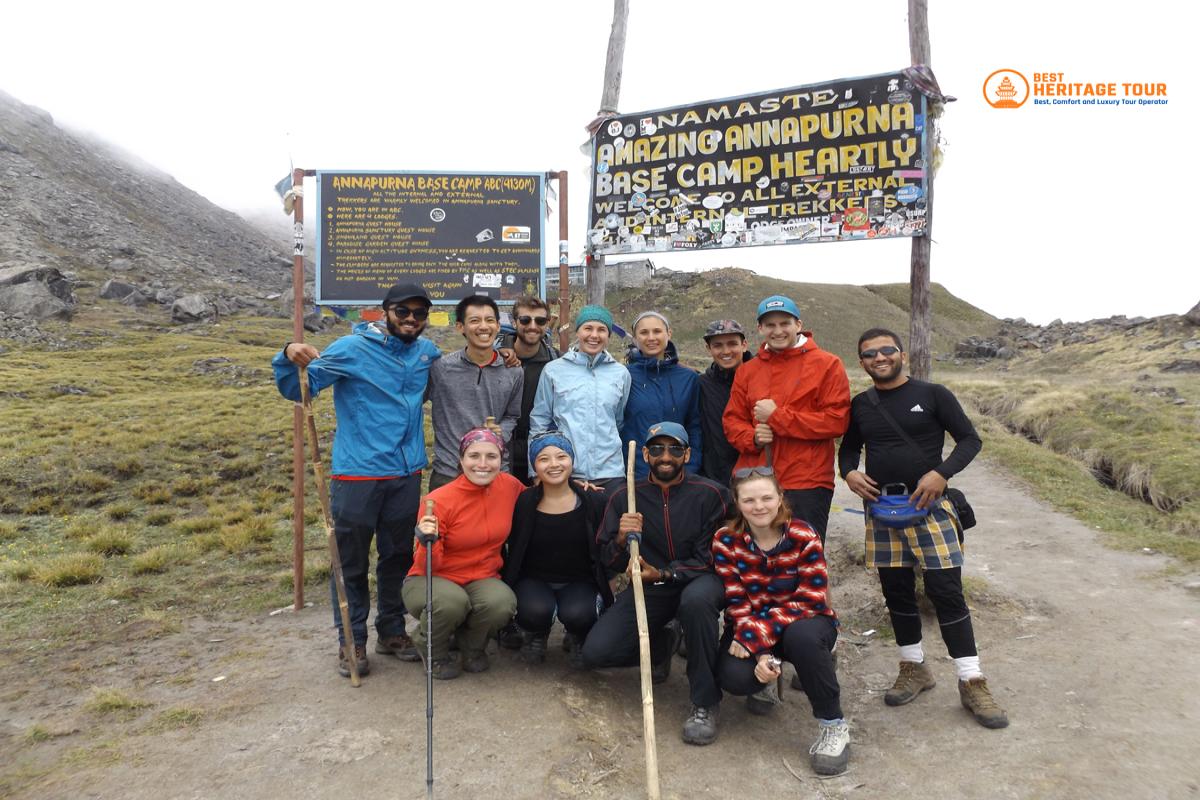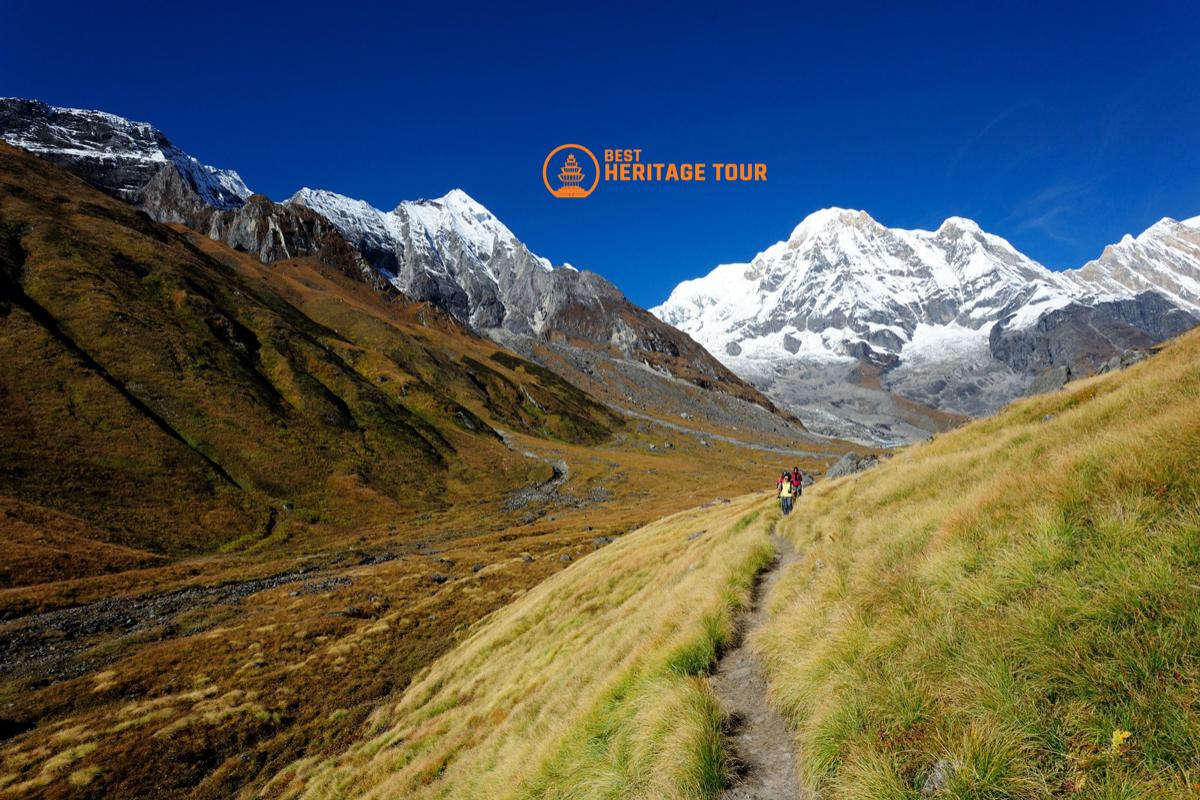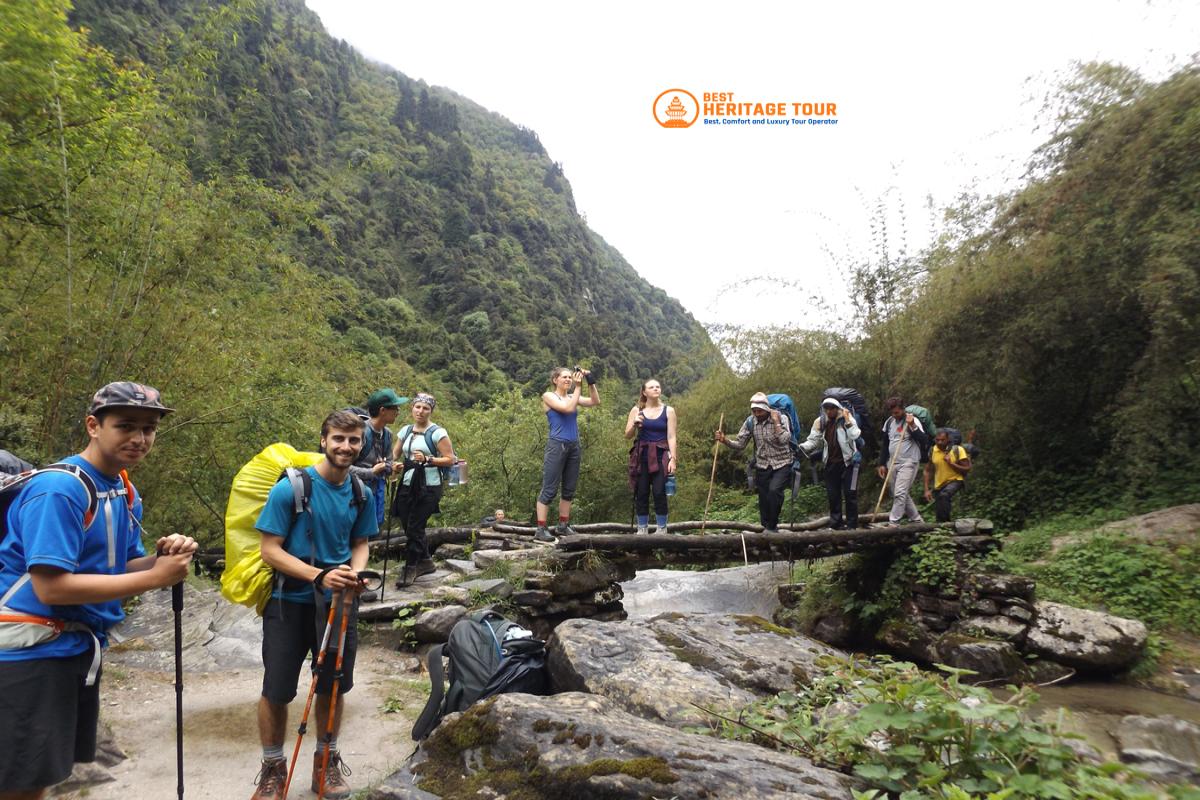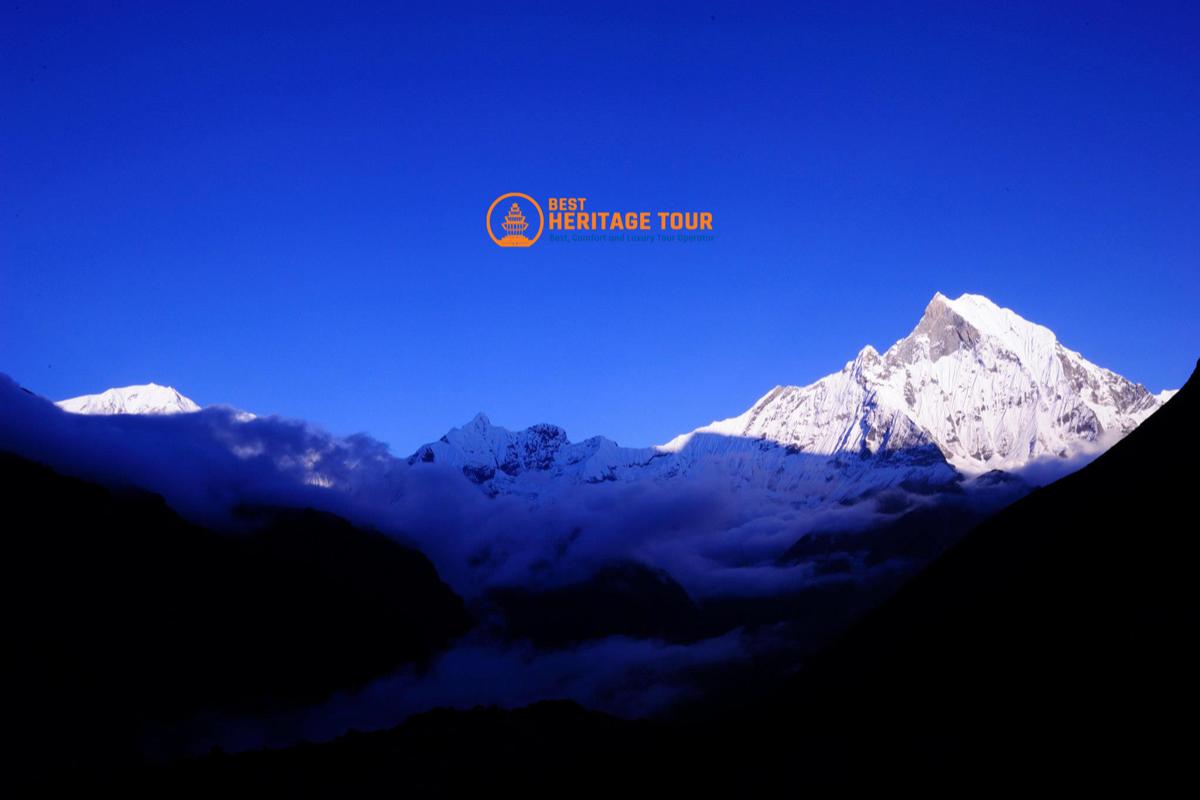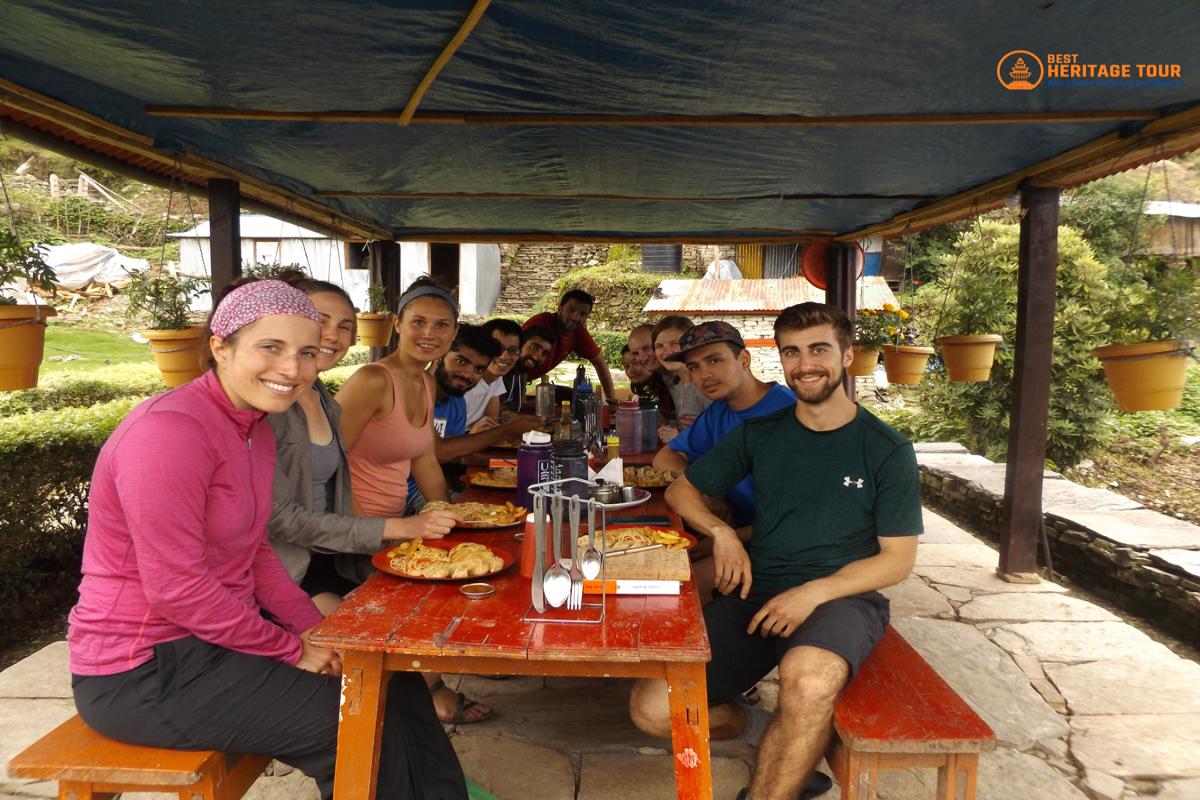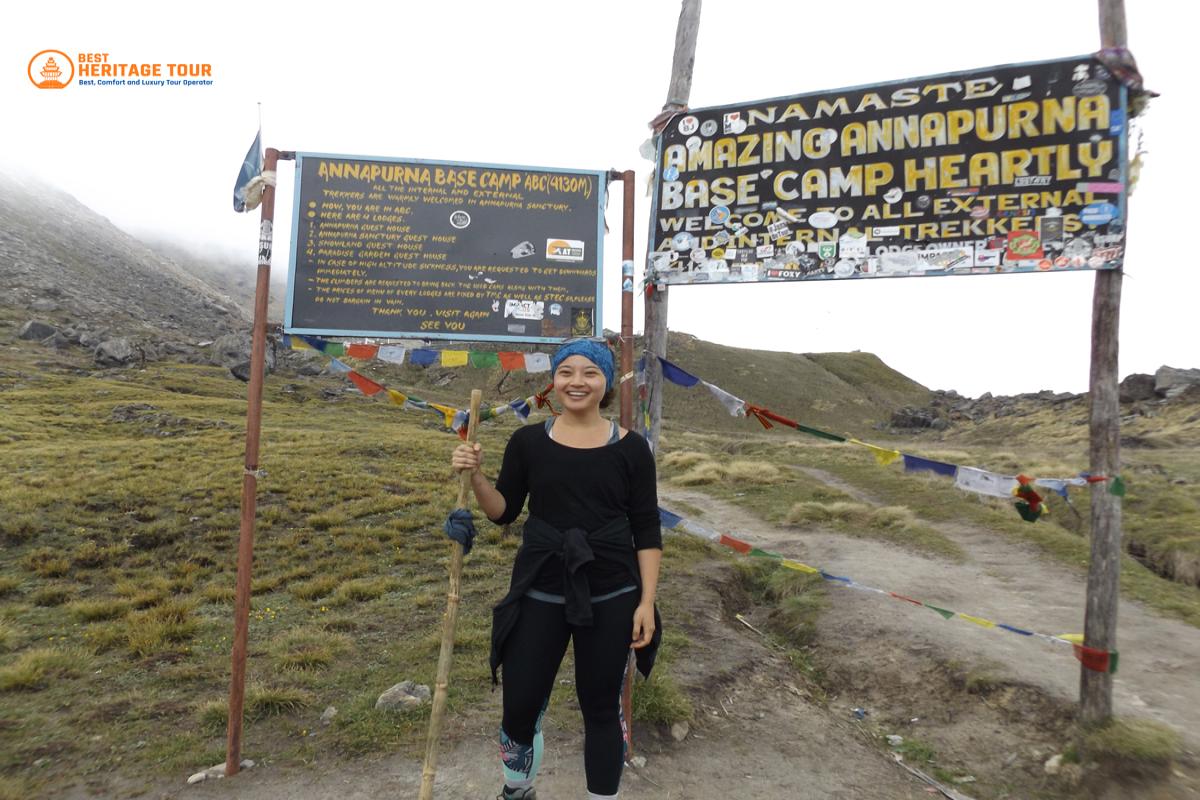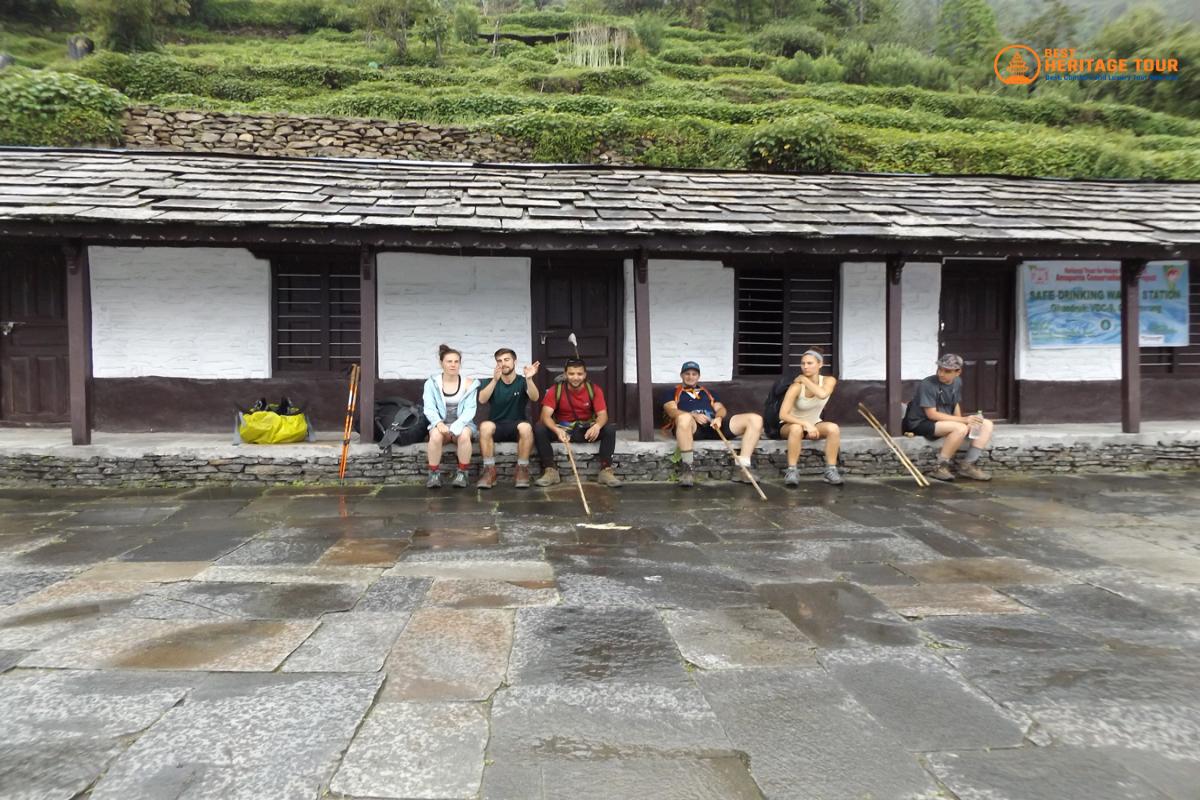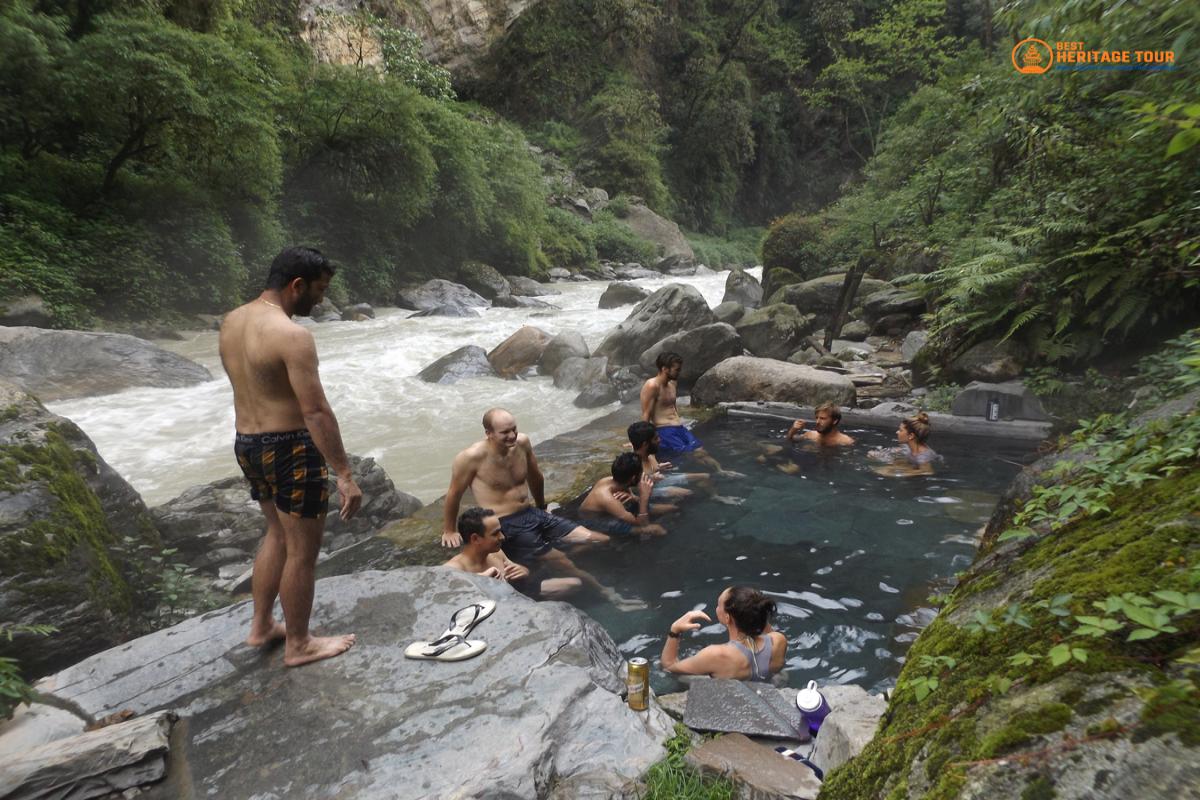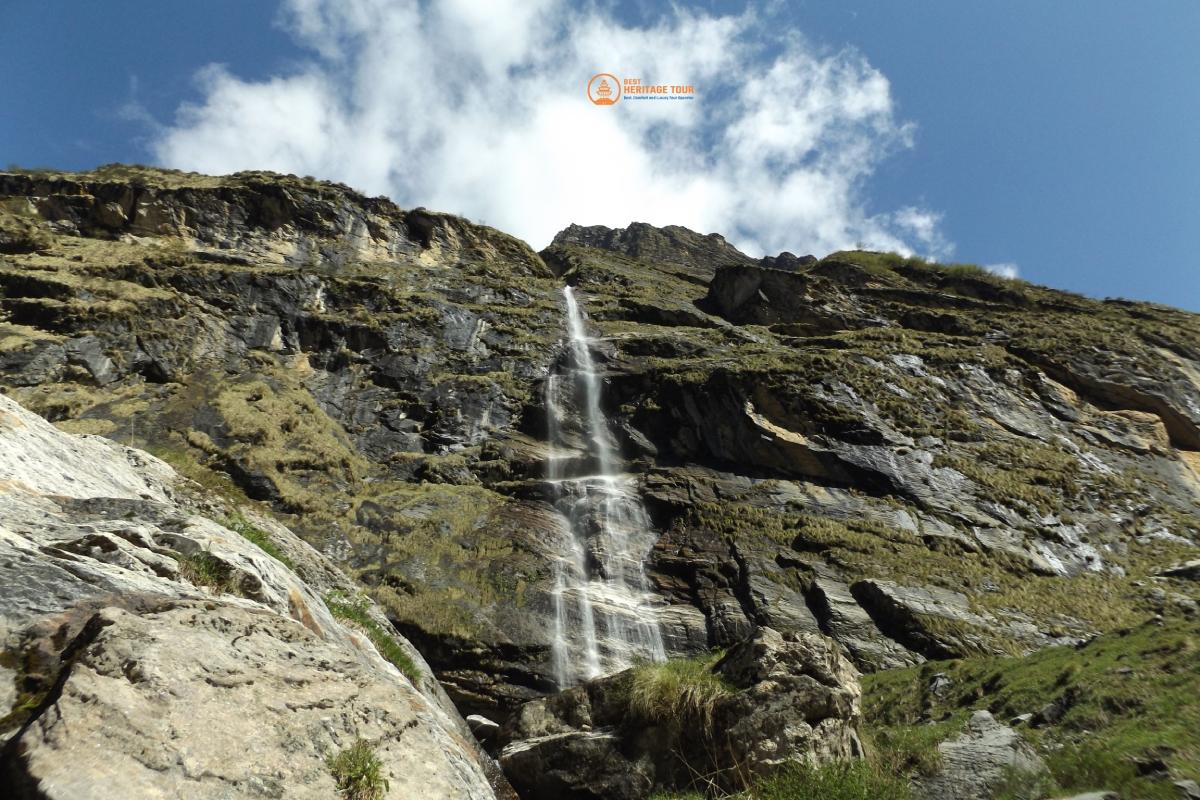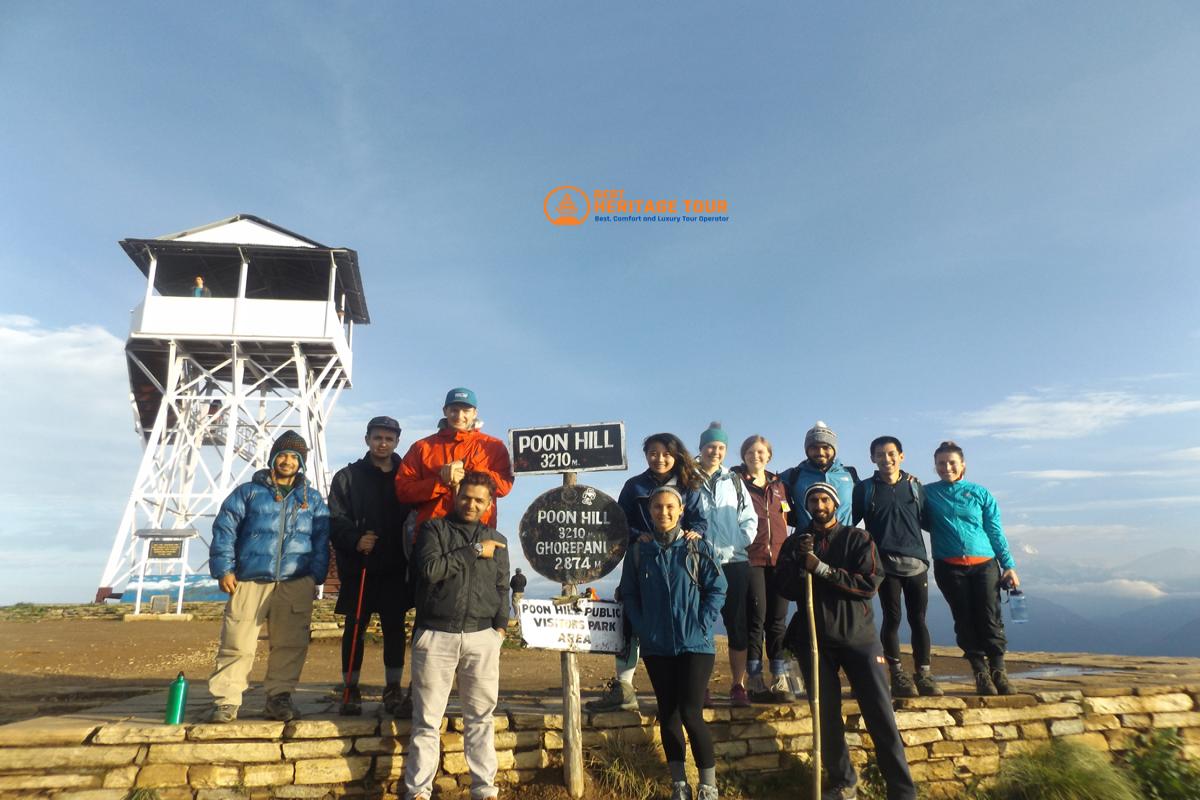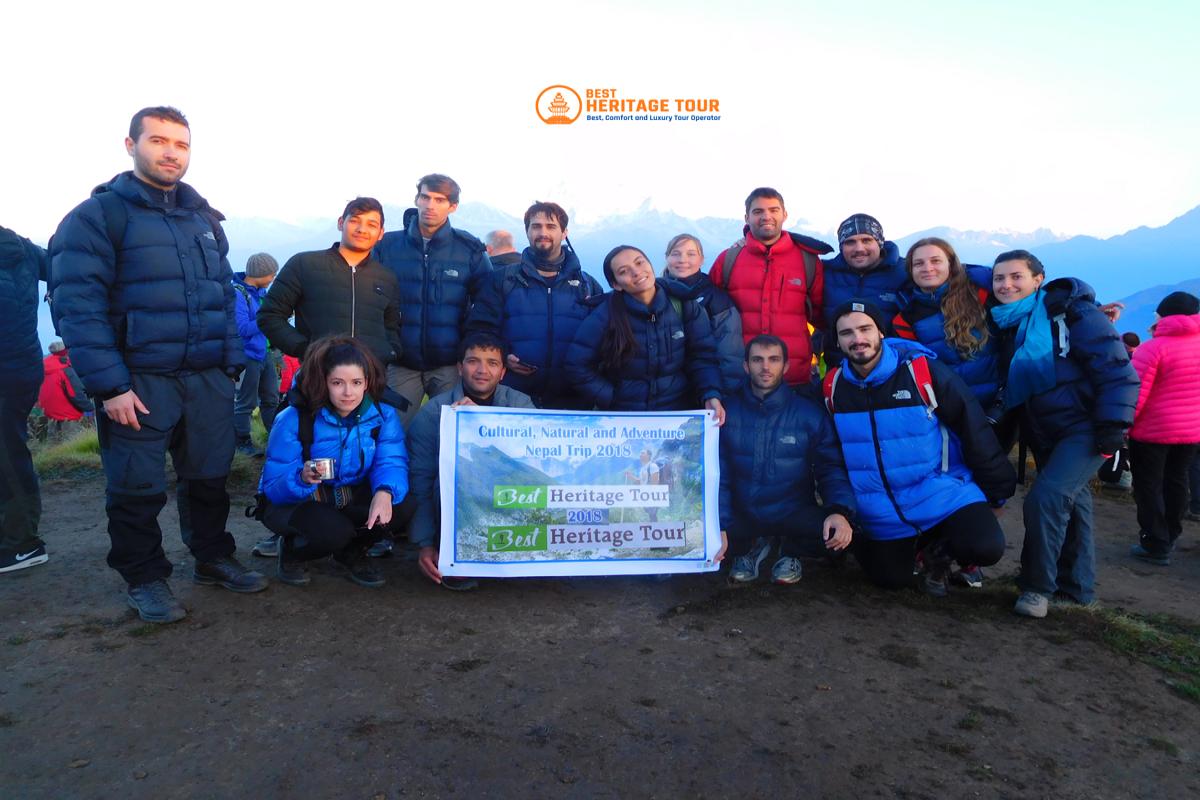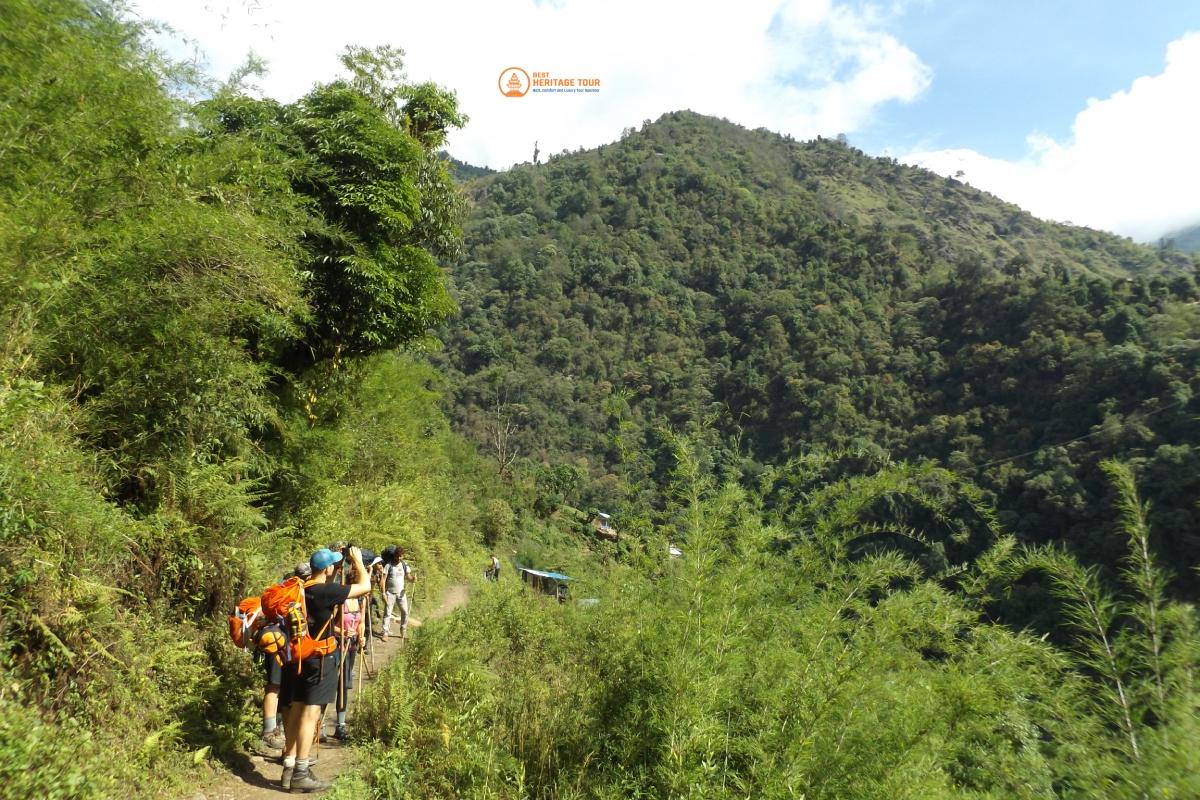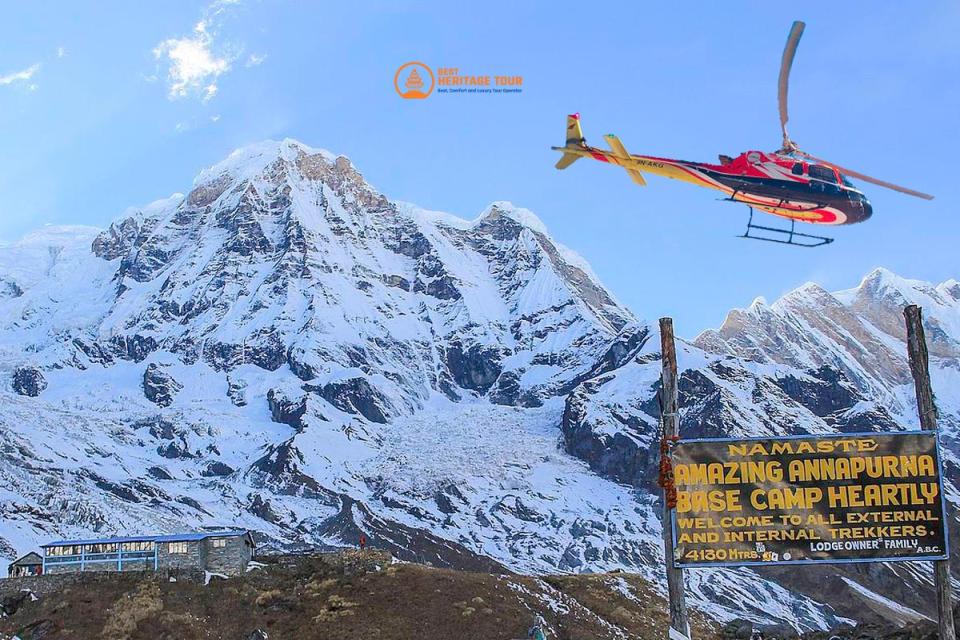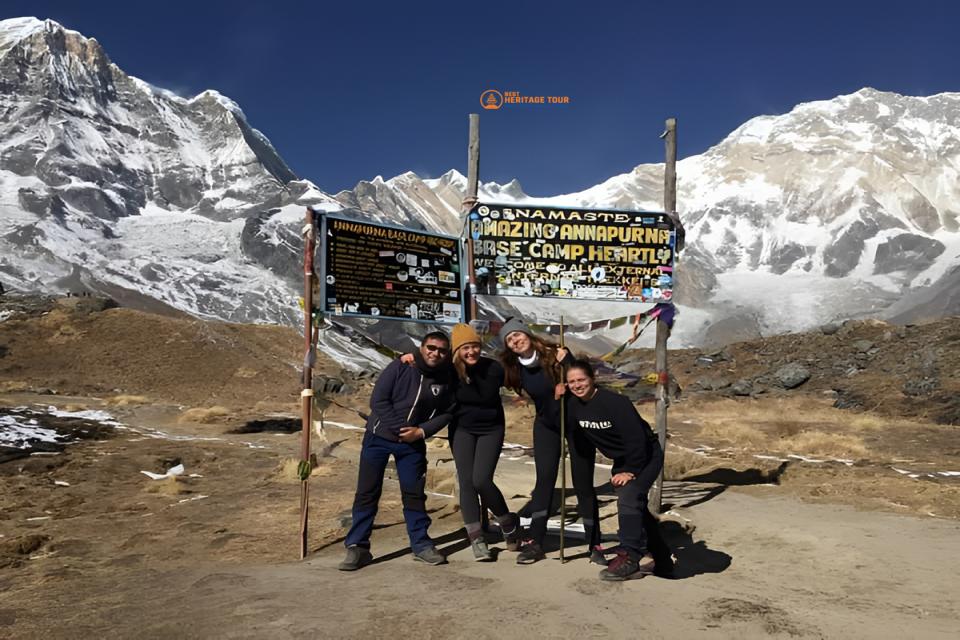Annapurna Base camp Trek - 11 Days
Insight on Annapurna Base Camp Trek
Embark on an exhilarating 11-day trek through the heart of the Annapurna region, where towering peaks, lush forests, and vibrant mountain villages await. This journey blends adventure with culture, as you pass traditional Gurung and Magar settlements, cross sparkling streams, and hike through rhododendron-filled trails. Witness the magical sunrise at Poon Hill, relax in natural hot springs at Jinu Danda, and stand in awe at the Annapurna Base Camp (4,130 m). Perfect for nature lovers and adventure seekers, this trek promises unforgettable landscapes, cultural encounters, and memories that last a lifetime.
Trip at a Glance
Key Highlights
- Trek through the heart of the Annapurna region, surrounded by towering Himalayan peaks.
- Experience the sunrise at Poon Hill with panoramic views of Annapurna, Dhaulagiri, and Machhapuchhre.
- Walk through lush rhododendron and oak forests, terraced fields, and cascading waterfalls.
- Explore traditional Gurung and Magar villages, experiencing local culture and hospitality.
- Reach the Annapurna Base Camp (4,130 m / 13,550 ft), a breathtaking high-altitude Himalayan sanctuary.
- Visit Machhapuchhre Base Camp, the base of the iconic “Fishtail” mountain.
- Relax in natural hot springs at Jinu Danda after days of trekking.
- Enjoy diverse trekking terrains, from moderate forest paths to challenging high-altitude trails.
- Witness dramatic landscapes, including alpine meadows, glacial moraines, and snow-capped peaks.
- Perfect mix of adventure, nature, and cultural experiences in a single trek.
Benefits of ABC Trek with Best Heritage Tours
- Free airport pickup and drop services on arrival and departure from your hotel with personnel transport
- Online trip briefing before & after booking confirmation
- Easy booking and reservation system
- Numerous communication channels (E-mail, WhatsApp, Facebook, Viber, Skype, Zoom)
- 24/7 phone support at: +977-9851149197 / +977-9810043046 for any assistance
- Easy payment system
- Available of luggage storage service without any cost during the trek
- Pulse oximeter to monitor blood oxygen saturation at high altitudes and detect early signs of altitude sickness and other health risks
- Provided sleeping bag and trekking poles (if you don't have your own)
Trip Overview
The Annapurna Base Camp (ABC) trek is one of Nepal’s most iconic Himalayan adventures, offering a perfect blend of breathtaking landscapes, cultural experiences, and thrilling trekking challenges. Spanning 11 days, this journey takes you from the tranquil streets of Pokhara through lush forests, terraced fields, and vibrant mountain villages, culminating at the awe-inspiring Annapurna Base Camp at 4,130 meters.
Starting with a scenic drive from Kathmandu to Pokhara, you will experience the beauty of Nepal’s countryside and the serene Phewa Lake. From Pokhara, the trek begins at Nayapul or Birethanti, passing through charming villages like Tikhedhunga and Ulleri, surrounded by dense rhododendron and oak forests. Each day brings new panoramas of towering Himalayan peaks, cascading waterfalls, and traditional stone and wooden houses, giving a glimpse into the lives of the local Gurung and Magar communities.
A highlight of the trek is the sunrise at Poon Hill, offering panoramic views of Annapurna, Dhaulagiri, and Machhapuchhre - truly a photographer’s paradise. Continuing through Tadapani, Chomrong, and Sinuwa, you gradually ascend toward Machhapuchhre Base Camp, experiencing varied terrains and breathtaking mountain vistas. Reaching ABC itself is an unforgettable moment, surrounded by towering giants like Annapurna South, Hiunchuli, and Machhapuchhre.
The descent introduces more serene landscapes, including natural hot springs at Jinu Danda, perfect for relaxation after days of trekking. The journey concludes with a scenic drive back to Pokhara and then Kathmandu, leaving trekkers with memories of dramatic peaks, local culture, and the serene Himalayan wilderness.
Ideal for moderately experienced trekkers, the Annapurna Base Camp trek combines physical challenge with soul-stirring beauty. From cultural encounters to panoramic mountain vistas, every step on this trail promises adventure, inspiration, and a lifetime of memories in the heart of the Nepalese Himalayas.
What to Expect on the Annapurna Base Camp Trek?
1. Breathtaking Himalayan Views
Prepare to be mesmerized by some of the world’s most iconic peaks. Annapurna South, Hiunchuli, Machhapuchhre, and Dhaulagiri rise dramatically against the sky, their snow-capped summits shimmering in sunlight. Every turn of the trail offers a new perspective, from jagged cliffs to serene valleys, leaving trekkers in awe of the sheer scale and beauty of the Himalayas.
2. Cultural Encounters
This trek is as much about people as it is about mountains. Passing through Gurung and Magar villages, you’ll be welcomed by smiling locals in traditional attire, offering a glimpse into centuries-old customs, crafts, and cuisines. From tea breaks in family-run lodges to observing local festivals and daily routines, every encounter is a cultural immersion.
3. Diverse Landscapes
The trail is a visual feast, shifting seamlessly from dense rhododendron and oak forests to terraced rice fields, babbling streams, and waterfalls. Higher altitudes reveal alpine meadows, rocky moraines, and panoramic ridgelines, while pristine glacial landscapes at Annapurna Base Camp create a dramatic contrast, highlighting Nepal’s diverse natural beauty.
4. Sunrise at Poon Hill
Experience the magical moment when the first rays of sunlight illuminate the Annapurna and Dhaulagiri ranges. The sky transforms into shades of gold, pink, and orange, casting long shadows over rolling hills and valleys - a breathtaking spectacle that stays etched in memory forever.
5. Physical Challenge & Adventure
Expect a rewarding blend of effort and exhilaration. Moderate to strenuous ascents test your stamina, while the high-altitude trails prepare you for the ultimate goal: Annapurna Base Camp at 4,130 meters. Each step brings a sense of accomplishment and deep connection with the rugged Himalayan environment.
6. Natural Hot Springs
After days of trekking, the thermal springs at Jinu Danda offer a blissful retreat. Soaking in warm, mineral-rich waters with the mountain breeze around you is a rejuvenating experience for both body and mind.
7. Serene Himalayan Wilderness
Away from crowded trails, enjoy the quiet majesty of the mountains. Listen to cascading waterfalls, chirping birds, and the rustle of the wind through pine forests. The peaceful environment allows for reflection and a deep connection with nature.
8. Memorable Moments
From village interactions to awe-inspiring vistas, every moment is unforgettable. This trek is not just a physical journey but a soulful adventure that leaves you with stories, memories, and experiences to cherish for a lifetime.
Are You Ready for Annapurna Base Camp trek?
The Annapurna Base Camp trek is an exciting adventure that will take you into the heart of the Himalayas. You will walk through beautiful forests, small mountain villages, and see some of the highest peaks in the world. This trek is best for people who are moderately active and ready for daily hikes of 4-7 hours with some steep paths. Although it can be challenging, every step is worth it for the amazing views and the chance to experience local culture.
You will also need to be mentally prepared. The trail can be steep, weather can change, and the teahouses are simple but welcoming. If you love nature, adventure, and the feeling of reaching a high mountain base camp at 4,130 meters, this trek is perfect for you. Say yes, take the challenge, and enjoy a life-changing journey in the Himalayas.
Itinerary
After an early breakfast, board a tourist bus to Pokhara (probably a 6-7 hour journey). On the way, you can see the picturesque Trishuli and Marsyangdi rivers, inter-connecting streams and small springs along the green rocky mountains. Pokhara is a beautiful valley known for several lakes, including Phewa Lake and Begnas Lake, and is located at the foothills of Annapurna (8,091 m), Machhapuchhre (6,993 m), Dhaulagiri (8,169 m), Manaslu (8,156 m) and Lamjung Himal (6,983 m).
After a breakfast by the banks of Phewa Lake in P{okhara, you take a short drive through beautiful countryside to Tikhedhunga. The road is very gentle and passes through Nayapul and then Birethanti. Along the way, you will see the magnificent terraced fields along the Burundi Khola.
After Birethanti, we will take an off-road drive to Tikhedhunga. The hike starts from Tikhedhunga, passes through the villages of Sudame and Hire, and ends at Ulleri (2,073 meters).
Today's hike will be a pleasant one with a gradual ascent. From the trail, you can enjoy views of the snowcapped Annapurna, Machhapuchhre and Hiunchuli mountains. As you hike through the rhododendron forest, you can see some wildlife, refreshing springs and rivers. You will then reach Ghorepani, a stunning hamlet perched on the mountain ridge.
The Himalayan views from this village are breathtaking with heavenly views of Dhaulagiri I, II, III, IV, V, Tukche, Dhampus, Nilgiri, Annapurna South, Bara Sikar and Machhapuchhre (commonly known as Fish Tail).
If you love sunrises, today is the day. You watch the sunrise over the Himalayas after reaching poonhill. From Poon Hill, you'll be able to see the dawn over more than 32 peaks of the Annapurna, Dhaulagiri, Nilgiri and Machapuchare mountain ranges. Poon Hill is famous for being a photo spot, so take as many photos as you like and enjoy Poon Hill.
After spending some time at Poon Hill, descend to the lodge/teahouse, have breakfast and start your trek to Tadapuni (2,630 m). However, to reach Tadapani you will pass Deurali (2,960 m) and Bantanti. If you reach Tadapani early, hike a little further to Chuire village.
Today's hike will vary slightly depending on where you stayed last night. Upon arrival at Tadapani, have breakfast and continue your journey to Chomrong (2,165m), passing through Chuile on the way. First pass the beautiful Ghandruk village and then a steep descent to the Kim Rong River before reaching Chomrong, where you can enjoy breathtaking views of Annapurna South and the Fishtail.
Located at the foot of the majestic Annapurna massif, Chomrong village is a popular overnight spot for those climbing to Annapurna Base Camp. However, if you stayed in Chuile last night, you will stop at Sinuwa to spend the night.
Today's hike will be a little longer. It will also depend a little on your previous overnight stay. If you have stayed overnight in Chomorong, you will descend a steep stone-top path to Chomorong Khola, but then the path will climb through bamboo, oak and rhododendron forests to reach Sinuwa. However, if you have spent the night in Sinuwa, your trek will start from Sinuwa. While trekking you can enjoy views of Machhapuchhre side by side views you will see the snow-capped peaks of Annapurna. The trail passes through the village of Kuldigal, descends to the hamlet of Bamboo Lodge and continues up into the Himalayan ranges (2,890m). If you start the trek from Sinuwa, stay overnight in Deurali.
After your last night in the Himalayas, you follow the route through a narrow gorge along the Modi Khola glacier valley, passing through more forest. You also pass a large protruding rock known as Hinku Cave and the Deurali hut, before arriving at the entrance to the Annapurna sanctuary. It eventually leads to ABC. However, if you have slept at Deurali, your trek will start from Deurali itself.
Throughout the day, you will hike close to the Annapurna glacier. On the way, the Machapuchare base camp offers breathtaking panoramic views of the surrounding mountains. You continue your journey northwest and finally reach ABC. ABC offers 360 degree views from Hiunchuli, Annapurna South to Annapurna I (8,097m/26,566ft), Kangsar Kang, Gangapurna, Annapurna III and Machhapuchhare.
Today's trek will take us close to some giant mountains including Annapurna massif (Annapurna I-IV), Dhaulagiri, Machhapuchhare, Manaslu, Gangapurna, Mt Tilicho, Mt Pisang, Paunda Danda and many other peaks with heights between 6,000-8,000 meters. The beauty of the snow-capped peaks surrounding you may make this a day you will never forget. You will stay night in base camp.
After leaving your footprints at ABC, it's time to head down. You head towards Modi River valley via the Annapurna Conservation Area. Finally, you reach your destination for the day, a tranquil stopover called Bamboo.
On your final day, complete the long journey from ABC to Bamboo and head to Jinu Danda. You firstly heads towards kimrong khola and climp up through oak forest and finally reached to jinu danda. Jinu Danda is an exotic place famous for its soothing natural hot springs that relax tired muscles, attracting thousands of tourists every year. From the hot springs you can enjoy views of forests which includes rhododendron and lush vegetation.
The last day of the trekking. After leaving Jinu Danda, you follow the dusty path to the right of Modi Khola. This part of the hike is the most relaxing walk of the entire trip. After about 3 hours of hiking, you will reach Siwa/Ghandruk Pedi where you will say goodbye to the hiking trail and drive through picturesque landscapes to Pokhara.
Depart Pokhara early in the morning and travel by tourist bus to Kathmandu. This 200km route follows first the Marsyangdi and then the Trishuli rivers and offers stunning views of natural landscapes and terraced fields. The bus will make a final climb and finally reach Kathmandu, where the journey began.
Later in the day, Best Heritage Tours will organize a farewell dinner.
Opt: If you want to skip the long drive, a 20-25 minutes flight from Pokhara to Kathmandu is available at an additional cost.
What is included?
- Tourist Bus Transportation between Kathmandu & Pokhara
- Private vehicle transportaion to Tikhedhunga (start of trekking) from pokhara and to phokara from Ghandruk Phedi (end of trekking)
- 2 nights accommodation in 3 Stars Hotel or similar in Pokhara with Breakfast
- Accommodation (8 nights in total): 4 nights accommodation with attached bathroom at Ulleri, Ghorepani, Chomrong and Jinu Danda. 4 nights in standard room (usually twin room) at Tadapani, Himalaya, Annapurna Base Camp, Bamboo
- All standard meals during the hike (9 lunches, 8 dinners, 9 breakfasts)
- State-certified experienced trekking guide and 1 assistant trekking guide for 12+ trekkers.
- Porters which will help trekkers with their luggage (with baggage limit of maximum 25 kg)
- Guide and porter fees - including food, insurance, salary, accommodation, transport and other necessary equipment
- All Permits fee: Annapurna Conservation Area Permit Fee (ACAP) & Trekkers Information Management System card (TIMS)
- Rescue in case of complicated health issues (funded by travel insurance)
- Souvenirs - Best Heritage Tour T-shirt and Purse
- Certificate of Best Heritage Tour after successful trek
- Farewell dinner at the end of trek in Kathmandu
What is not included?
- International airfare
- Nepal visa fee (15 days: $25-30, 30 days: $40-50, 90 days: $100-110)
- Excess baggage fee for porters
- All food and accommodation in KTM before and after the trip
- Additional accommodation and meals in Kathmandu and Pokhara due to early arrival or late departure, early return from the trek.
- Lunch and dinner in Pokhara
- Personal expenses (shopping, snacks, mineral or boiled water, hot (tea, coffee) and cold drinks, hot showers, alcohol, Wi-Fi, telephone, battery charging fees, additional carriers, etc.)
- Personal clothing and equipment
- Travel insurance (mandatory) should cover medical, as well as emergency rescue and evacuation at high altitudes.
- Tips for guides and porters (Customary)
- Anythings that is not mentioned in Itinerary & Included section
- Additional costs resulting from factors beyond our control, such as landslides, weather conditions, itinerary adjustments due to safety concerns, illness, changes in government policies, strikes, etc.
- All government taxes 13%, SSF, and 10% service charges
Route Map
Equipment
Head
-
Sun protection: hats or scarves
-
Winter headwear: warm insulating hats or wide-brimmed hats
-
Headlamp with spare batteries
Face
-
Sunscreen
-
Sunglasses with UV protection
-
Face and body cleansing wipes
Hands
-
Lightweight gloves for general use
-
Heavy-duty winter gloves for extreme cold
Body Clothing
-
Performance hiking shirts and long-sleeved shirts
-
Hooded rain jackets for wet weather
-
Fleece jackets for insulation
-
Breathable trekking pants
-
Lightweight wool T-shirts
-
Polypropylene underwear for moisture management
-
Down jackets (available for rent)
-
Sweaters for extra warmth
-
Waterproof jackets and pants
Footwear
-
Sturdy hiking boots
-
Thick wool socks with extra lightweight socks
Essential Gear
-
Backpack & daypack
-
Thermal bottles for water
-
Water purification systems
-
Trekking poles for support
-
Sleeping bags (preferably rated for -15°C)
Toiletries
-
Quick-drying towel
-
Toothbrush, toothpaste, deodorant, dental floss
-
Biodegradable soap
-
Nail clippers and compact mirror
Personal Accessories
-
Cash and financial essentials
-
Watch
-
Mobile phone and camera
-
First-aid kit
-
Passport photos and photocopies
-
Notebook and pen
-
Binoculars
Trip Info
Best Time for the Annapurna Base Camp Trek
- Spring Season (February-June)
Spring is one of the most popular times for the trek. The weather is generally warm and clear, and the forests are full of blooming rhododendrons and wildflowers, making the trails colorful and lively. Daytime temperatures are comfortable for trekking, and mountain views are often spectacular. Late spring (May-June) can get warmer at lower altitudes, but higher regions remain cool and pleasant.
- Autumn Season (September-December)
Autumn is another excellent time to trek. After the monsoon, the air is fresh and clear, offering crisp, unobstructed views of the mountains. The weather is stable, making it ideal for trekking. This season also allows you to enjoy the cultural beauty of villages along the trail and the golden hues of the fields and forests.
- Other Seasons
The monsoon season (July-August) is not recommended due to heavy rain, slippery trails, and limited visibility of mountain views. Winter (January) can be very cold, especially at higher altitudes, and snow may make trekking challenging.
Summary: The trek is best done between February to June and September to December, offering safe trails, clear skies, and breathtaking Himalayan views.
Permits Required for the Annapurna Base Camp Trek
To trek in the Annapurna region, you will need the following permits:
-
Annapurna Conservation Area Permit (ACAP)
-
Trekkers’ Information Management System (TIMS) Card
All permits are included in the package and will be arranged by us, so you don’t need to worry about them. Make sure to carry a few passport-size photos and your passport copy, as these are required for permit applications.
Accommodations & Meals
During the trek, you will enjoy a comfortable mix of private rooms with attached bathrooms and teahouse/lodge stays with twin-bed rooms and shared bathrooms. The private rooms provide extra comfort and privacy, while the teahouses offer a cozy, authentic mountain experience. All lodges are clean, welcoming, and provide a warm place to rest after long days of trekking. Hot showers are available at most stops, ensuring you feel refreshed and ready for the next day’s adventure.
Meals are freshly prepared at the lodges along the trail, offering a mix of Nepali and continental dishes. Breakfast usually includes porridge, eggs, toast, or pancakes. Lunch and dinner feature dal bhat (rice and lentils), noodles, momos, soups, or pasta, with vegetarian options available. Special dietary requirements can be managed if notified in advance. Trekkers are advised to carry snacks or energy bars to stay energized during long trekking hours.
A Typical Day trekking on the Annapurna Base Camp Trek
A typical day on the trek starts early in the morning with a light breakfast to prepare for the hike. You will walk through forests, rivers, and mountain trails, passing small villages along the way. Most days involve 4 to 7 hours of trekking, with plenty of breaks to rest and enjoy the beautiful scenery. Around midday, you will stop at a lodge or teahouse for lunch before continuing your hike in the afternoon.
In the late afternoon, you will reach your lodge, where you can rest, freshen up, and relax. Dinner is served in the lodge, and evenings are usually spent resting or enjoying the mountain views. At higher altitudes, it’s important to get plenty of rest to prepare for the next day’s trek.
Physical Fitness
The Annapurna Base Camp trek is moderate to strenuous, so a reasonable level of fitness is important. You don’t need to be an athlete, but being active and physically prepared will make the trek more enjoyable. Daily hikes range from 4 to 7 hours on hilly and sometimes steep trails, so endurance, leg strength, and stamina are helpful.
To prepare, it is recommended to walk or hike regularly, do some cardio exercises like jogging or cycling, and practice stair climbing before the trek. Simple exercises like squats, lunges, and core workouts can also help. Being physically ready will allow you to enjoy the journey, take in the views, and handle the higher altitudes comfortably.
Health & Safety on the Trek
Health and safety are very important while trekking in the Himalayas. Make sure you are in good physical condition and take your time to adjust to higher altitudes. Altitude sickness can happen, so drink plenty of safe water - boiled, filtered, or bottled and avoid drinking from rivers or streams. Carry a personal water bottle or hydration system to stay hydrated throughout the day.
Eat freshly cooked food at lodges or teahouses and avoid raw food to prevent stomach issues. Wash your hands or use hand sanitizer before eating, and stick to familiar foods if you have a sensitive stomach. Eat regular, balanced meals to keep your energy up. Always walk carefully on steep or uneven trails, use trekking poles for support, and follow your guide’s instructions.
Visa for Nepal
All travelers (except Indian citizens) need a Nepal tourist visa to join the Annapurna Base Camp trek. Visas are easily available on arrival at Tribhuvan International Airport in Kathmandu or at certain land border entry points. The process is simple - fill out a form, provide a passport-sized photo, and pay the visa fee for 15, 30, or 90 days depending on your travel plans. Make sure your passport is valid for at least six months, and if you want to save time, you can also apply online through the official Nepal Immigration website before arriving.
Travel Insurance
Travel insurance is essential for the Annapurna Base Camp trek and should cover medical emergencies, evacuation, and high-altitude trekking. Accidents, illness, or altitude-related sickness can happen, so having proper insurance ensures you are protected and can get help if needed. Make sure your policy specifically includes trekking up to 4,500 meters or higher. Carry a copy of your insurance documents and share the details with us.
Booking & Payments
To confirm your Annapurna Base Camp Trek, a 10% deposit is required at the time of booking, with the remaining balance payable before the trek begins. Payments can be made via bank transfer, credit card, or cash, though credit card payments may include additional charges. The cancellation policy depends on how far in advance you cancel, and full details are provided before booking or you can read our Terms & Conditions. Group discounts are available for larger bookings, and private departures can also be arranged to suit your preferences.
Last Minute Booking
While booking in advance is recommended, Best Heritage Tour also accommodates last-minute bookings for the Annapurna Base Camp Trek. For these, full payment (100% of the trip price) is required at least 24 hours before departure. Please note that availability of lodges, permits, and guides may be limited, especially during peak seasons. Despite these challenges, last-minute bookings can still be arranged with proper coordination. For more information or to make a last-minute booking, contact us at +977-9851149197 / +977-9810043046 or email info@bestheritagetour.com / bestheritagetour@gmail.com.
Trip Extension
If you wish to extend your adventure beyond the Annapurna Base Camp Trek, Best Heritage Tour offers several exciting options. You can explore other trekking routes such as Mardi Himal, Annapurna Circuit or Everest Base Camp Trek for a broader Himalayan experience. Alternatively, you can enjoy cultural tours in Kathmandu Valley, visit serene villages, or relax in Pokhara by Phewa Lake. Our team will help create a customized itinerary based on your interests, schedule, and fitness level, ensuring a seamless and unforgettable extension to your journey.
Review
Memorable ABC trek and amazing guide
I recently complete the 11-days ABC trek and it was an absolutely amazing! From beginning to end, everything was well-organized by the Best Heritage Tour, and the breathtaking...
View DetailWhat an amazing trek man!!!
What an amazing trek route and trail. Every moment during the trek was an absolutely amazing. The beautiful mountains and valleys during the trek make me feel amazing. Each corners...
View DetailGreat service and an amazing guide
Me, my husband and my sister recently completed the ABC trek, which was an unforgettable adventure filled with breath-taking Himalaya’s views, exciting trekking and warm...
View DetailWorthy Trek of my life
I did the ABC trek with Best Heritage Tour and I cannot stop praising them. What an incredible service they provide to me, starting from the airport pick up till to the departure....
View Detaildelivered what they promised
My Annapurna Base Camp trek was really unforgettable journey, with right weather, sunlight and fresh snow experience. Our guide, Madhav, and Porter, Hari, were incredibly...
View DetailUnforgettable trek of my life
I recently completed the Annapurna Base Camp Trek (11 days) with the Best Heritage Tour, and it was actually a lifetime experience! The moment I booked the journey, the team was...
View DetailIncredible Annapurna Base Camp Trek
As a solo traveler, I have an amazing experience on 11 Days ABC trek by Best Heritage Tour. As soon as I contacted the Best heritage tour, they were very friendly and attentive. I...
View DetailFAQ's
Absolutely! In addition to the Manaslu Circuit trek, Best Heritage Tours also organizes treks to other popular destinations such as Everest Base Camp, Annapurna Circuit, and Langtang Valley, offering a diverse hiking experience throughout Nepal.
Yes, all our guides are fluent in English and many speak other languages. This facilitates clear communication and enhances your overall experience.
Most trekking guides in Nepal speak basic to advanced English, which is enough for general communication about trekking and safety precautions. Some speak more fluent English, which will improve your overall trekking experience.
Yes, most visitors need a tourist visa to enter Nepal. A visa can be obtained on arrival at Tribhuvan International Airport in Kathmandu or applied for in advance at a Nepalese embassy or consulate.
Yes, you will need two passport-sized photos for both the visa application and the trekking permits, so it's a good idea to bring extra copies just in case.
You'll need a valid passport (with at least six months validity), a passport-sized photo, and the visa fee (which varies depending on the duration of stay).
To obtain the RAP, you’ll need:
- A valid passport.
- A Nepal visa.
- Travel insurance.
- Two passport-sized photos.
- A letter from your trekking agency detailing your itinerary and the names of the guide and group.
Yes, it’s possible to extend your visa if you wish to stay longer in Nepal. Extensions can be processed at the Department of Immigration in Kathmandu or Pokhara, but you should apply before your current visa expires.
You can exchange US dollars or Euros for Nepalese rupees upon arrival, but we recommend carrying cash in the local currency for most transactions outside of major cities.
Facilities may vary, but most teahouses offer the following:
- Basic bedding (mattress, pillow).
- A dining area for eating meals.
- Charging options for electronic devices (usually for a fee).
- Limited Wi-Fi access.
Hygiene standards may vary. Most teahouses strive for cleanliness, but it is wise to temper your expectations, especially in remote areas.
Yes, teahouses are generally safe and many hikers have had good experiences with them, but it's wise to use common sense, lock up your valuables, and choose a reputable establishment recommended by your guide.
To ensure you are comfortable while trekking, your backpack should ideally weigh 10-15% of your body weight, usually around 10-15 kg (22-33 lbs).
Physical preparation is essential to a successful trekking experience. Begin an exercise program 6-8 weeks before your hike that focuses on:
- Aerobic exercise: Activities such as running, cycling, and swimming to improve endurance.
- Strength training: Leg, core, and upper body exercises to increase strength.
- Practice hiking: Fill up your backpack and go on a short hike to simulate trekking conditions.
Hiring porters is not mandatory but highly recommended. Carriers allow you to carry heavy loads and make the hike more comfortable. This also supports the local economy and creates jobs in the area.
It is important to stay hydrated while climbing. Bring a reusable water bottle and use water purification tablets or a filter if necessary. Pack energy-rich snacks such as nuts, energy bars and dried fruit to maintain your energy levels throughout the day.
Before any hike, test your equipment on a training hike to make sure everything fits well and works properly. Ensure that you break in your trekking footwear to prevent blisters and discomfort.
Yes, we recommend that you have a small first aid kit with some basic items such as adhesive tape, disinfectant wipes, painkillers, altitude sickness medication, and personal medications.
Yes, you can rent trekking gear in Kathmandu and other major cities. However, we recommend that you check the quality and suitability of the equipment before renting.
Acclimatization helps your body adapt to high altitudes and reduces the risk of altitude sickness. Gradual ascents and rest days are essential to acclimatize effectively.
Pay attention to your body's signals, especially when fatigue sets in.
- Take a break: Take a break when necessary and find a comfortable place to sit and relax.
- Stay hydrated: Drink water regularly and eat snacks to replenish your energy.
- Inform your tour guide: Should you begin to feel unwell, it is important to communicate this to your tour guide. They can assist in modifying the pace and itinerary as needed.
Training at altitude helps your body adapt to lower oxygen levels, which can be beneficial for hiking. However, it is not absolutely necessary. Being in good cardiovascular condition can also prepare you for the conditions.
In the event of altitude sickness, it is vital to descend to a lower elevation immediately and take time to rest. Drinking plenty of fluids and taking over-the-counter medications (such as ibuprofen) can help reduce symptoms. See a doctor if symptoms persist.
Consult your doctor for individual vaccination recommendations. Common vaccinations climbers should consider include:
- Tetanus
- Hepatitis A and B
- Typhoid
- Rabies (if in contact with wild animals)
The main health risks while trekking include:
- Altitude sickness: occurs when you ascend too quickly without adequate acclimatization, causing symptoms like headaches, nausea, and fatigue.
- Dehydration: Insufficient fluid intake can cause fatigue and headaches.
- Injuries: Falls and slips on uneven surfaces can cause sprains and fractures.
Trekkers are strongly encouraged to take out travel insurance. Make sure your insurance covers high altitude hiking, medical evacuation and trip cancellation. This gives you peace of mind and financial protection in case of emergencies or unexpected events.
In case of emergency:
- Keep calm: Staying calm helps you make better choices.
- Contact your tour guides. They are trained to deal with emergencies and know what is best.
- Use communication devices: If necessary, you can use satellite phones and emergency transmitters for communication in remote areas.
In remote and secluded areas, maintaining a sense of connection can prove to be quite challenging.
- Cellular Network: Most areas along the trek have good mobile coverage, especially in larger villages such as Samagaon. However, signals can be unreliable.
- Wi-Fi Availability: Some teahouses offer Wi-Fi, but the connection can be slow and there may be a charge.
- Satellite Phone: If traveling to an area without cell coverage, consider renting a satellite phone in case of emergency.
Yes, Nepal offers an electronic visa (e-visa) that can be applied for online before arriving. This process enables you to bypass the visa queue upon arrival at the airport. After completing the online application, you can get your visa stamped on arrival.
The tourist visa fees are as follows:
• 15 days: USD 30
• 30 days: USD 50
• 90 days: USD 125 Note that these fees are subject to change, so check the current visa fees before your trip.
No, previous trekking experience is not mandatory. However, a good level of physical fitness is necessary, as the trek involves walking for 5-7 hours per day and ascending to high altitudes.
Most teahouses in remote areas do not allow online reservations. However, during peak seasons, guides or trekking agencies can help secure rooms in advance. It’s recommended to have a guide manage accommodations, especially in crowded seasons.
Yes, teahouses usually provide blankets, but they may not always be warm enough at high altitudes. Bringing your own sleeping bag rated for cold weather is essential.
Yes, it's recommended to bring your own trekking poles. They provide essential support during steep ascents and descents, and are particularly helpful for managing balance on rough terrain.
You should bring sturdy, waterproof trekking boots with good ankle support. Ensure they are well broken-in before the trek to avoid blisters or discomfort.
Start a fitness routine several months before the trek to gradually build strength and endurance. Even light to moderate exercise a few times a week can help condition your body. You can also opt for shorter and easier treks first to gain experience.
Yes, waterborne diseases are a concern in remote areas. Always drink purified or boiled water. Bring water purification tablets or a portable water filter to treat water from local sources.
Yes, if you wish to extend your stay, you can apply for a visa extension at the immigration office in Kathmandu or Pokhara.
While Nepali is the primary language, most staff members in lodges speak English, and some may even speak other languages. Communication should not be an issue for international tourists.
It’s advisable to be up-to-date on routine vaccinations, including hepatitis A and typhoid. Talk to your doctor about the vaccinations you need for Nepal.
This trek is situated in the central part of Nepal, specifically within the Annapurna Conservation Area, at an altitude of 4,130 meters (13,550 feet).
Yes, this tour is fully guided by experienced and certified local guides, ensuring safety and enriching your trekking experience.
It’s important to note that once you’re on the trek, cash is king. Here’s how you can manage payments:
- Cash Payments: Teahouses, shops, and most service providers along the trekking route only accept cash in Nepali Rupees (NPR). It’s advisable to carry enough cash for your entire trek before leaving Pokhara.
- ATMs: There are no ATMs after you leave Pokhara, so you’ll need to withdraw all your cash before heading out. Keep in mind that ATMs in Pokhara may have withdrawal limits, and it’s wise to bring more than you think you’ll need.
- Currency Exchange: You can exchange foreign currency at exchange counters in Kathmandu or Pokhara, but rates tend to be more favorable in Kathmandu. Always check the latest exchange rates.
Hot showers are available in some teahouses for an extra fee, but Wi-Fi is scarce and often comes with additional costs.
- Cardio: Running, swimming, or cycling 3-4 times a week can improve endurance.
- Leg Strength: Include exercises like squats, lunges, and hiking on hilly terrain to prepare your legs for the varied elevation gains.
- Endurance: Long walks with a backpack, gradually increasing your distance and weight, will help your body adjust to carrying a load for extended periods.
Always check travel advisories from your government and the local situation before planning your trip. Nepal is generally safe for tourists, but it's wise to stay informed about political and environmental conditions.
Choosing the best heritage tour provides an enriching cultural experience, blending education, comfort, and unique local interactions for unforgettable travel memories.
The majority of international flights arrive at Tribhuvan International Airport, which is located in Kathmandu. From this location, travelers can connect to Lukla to commence their trekking journey.
You typically need a valid passport, a completed visa application form, and a passport-sized photo. Payment can be made in cash or via card at the airport.
Yes, tourist visas are eligible for extension at the Department of Immigration located in Kathmandu. Ensure you have a valid reason and required documents for the extension.
Annapurna Base Camp Trekking is a popular trekking route in Nepal that takes you to the base of Mount Annapurna, the 10th highest mountain in the world at 8,091 meters (26,545 feet).
Treks usually take 7-12 days depending on your starting point and itinerary. Some trekkers combine it with the Ghorepani Poon Hill trek, which can add a few days to the duration.
The best times for ABC hiking are spring (March to May) and autumn (September to November). During this time, the weather is generally stable and the skies are clear, allowing for the most beautiful views.
The Trek to ABC is moderate difficulty. It requires hiking for 5-7 hours a day over steep and rough terrain with several meters of elevation gain. This hike is doable for most fit hikers, but some hiking experience is an advantage.
Hiring a guide or porters is not mandatory, but we highly recommend it, especially if you are not familiar with the area. A guide will provide local knowledge and keep you safe, and a porter will help carry your heavy packs, making the hike more enjoyable.
the Annapurna Conservation Area Permit (ACAP) and the Trekker Information Management System (TIMS) card.
Accommodation is lodges/hotels along the route. They offer simple rooms and usually have shared bathrooms. Food includes typical Nepalese dishes such as dal bhat (rice and lentils) as well as international dishes such as pasta, noodles and pancakes.
Annapurna Base Camp is located at an elevation of 4,130 metres (13,549 feet). Altitude sickness can be an issue, so it's important to acclimatize properly and ascend slowly.
Essential items include trekking boots, warm clothing (layers), a quality sleeping bag, a backpack, a first aid kit, water purification tablets, and trekking poles. It's important to pack light, but be prepared for changing weather conditions.
Cell reception is available in some areas of the hike, but may be spotty. Many tea houses offer Wi-Fi for a small fee, but the connection can be slow and unreliable, especially at higher altitudes.
Altitude sickness or acute mountain sickness (AMS) occurs at an altitude of 2,500 meters. Symptoms include headache, nausea, dizziness and shortness of breath. It is important to acclimatize properly, drink plenty of fluids and listen to your body. If symptoms worsen, it is essential to descend to a lower altitude.
Treks usually start from Nayapul or Ghandruk, which are a few hours drive from Pokhara. Pokhara is about a 6-8 hour bus ride or 30 minute flight from Kathmandu.
The trek is generally safe, however as with all Himalayan treks there are inherent risks involved, including altitude sickness, changing weather and trail conditions. Hiring an experienced guide and ensuring proper acclimatization will greatly increase your safety.
Yes, it is possible to hike alone, especially in high season when the trails are crowded. However, for safety reasons and companionship, we recommend hiking with a group, a guide, or at least a partner.
The trek will take you through traditional Gurung and Magar villages, where you will experience the local culture, customs and hospitality. You will also come across Buddhist prayer flags, monasteries and chortens along the way. Please feel free to contact us if you have any queries.
If you wish to extend your stay in Nepal beyond your visa’s initial duration, you can do so by applying at the Department of Immigration in Kathmandu. Extensions are available for a maximum of 30 days, and it’s recommended to apply before your current visa expires. Best Heritage Tour can help you with the extension process if required during your Australian Camp Trek.

